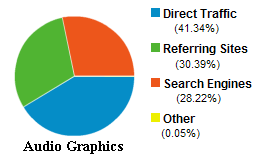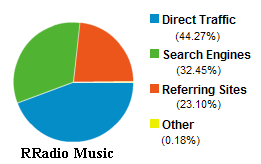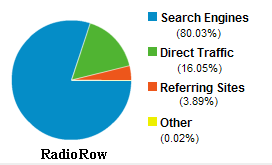 Analytics, Metrics and Music for the Radio Industry
Analytics, Metrics and Music for the Radio Industry
 An Indie Artist Pipeline to Internet Radio
An Indie Artist Pipeline to Internet Radio
 Radio Industry ROI Strategy
Radio Industry ROI Strategy
 A New Breed of Indie Artists
A New Breed of Indie Artists
How to Find Radio Station Web Sites
Most people in the radio industry are confident that listeners will have no trouble finding their station web site. The name is ingrained in the audience through repetition on air. But, beyond those mentions, how much farther do you go to a) promote your web presence within your market, or b) attempt to bring in online listeners from outside your ADI?
It's a question that requires an answer if radio, going forward, is to place more dependence on interactive ad dollars.
| "Usually a web site's function will determine where the majority of visitors come from." |
Do you know where your online audience comes from? How closely do you monitor "traffic sources" - the variety of ways consumers find your radio web site? We could get granular by identifying individual sites that send traffic your way, but I'm going to guess that these "referring sites" are not big sources for driving audience to any station site. |
"Referring sites" is one of three categories of "Traffic Sources" on Google Analytics and most other web-analysis programs. It represents any web site with a link to yours.
"Search engines" is a second category of "Traffic Sources" - easy to understand, it's the number of people coming to your site from any search engine. Your analytic programs will break down which search engines are sending how much trafffic.
The third "source" is "Direct Traffic." How many persons each month come directly to your radio station web site, by either typing in the URL after hearing it promoted or having your site bookmarked. It's in this category that many of the radio industry's online consumers are going to be coming from.
Usually a web site's function will determine how the majority of visitors find it. As an example, let's use AudioGraphics.com, RadioRow.com, and RRadioMusic.com - all Audio Graphics properties. Here are the charts showing the percentage of traffic in the last thirty days.
 |
 |
The 2 charts above are expected to have more "direct" visitors. Both are aimed at groups who come to each site for specific information. The RadioRow chart - at right - reflects a web site that's aimed at consumers, and which builds its traffic from high search engine returns. |
 |
Knowing where your visitors come from helps in focusing where your energy needs to be placed.
With the radio industry seeing an increase in national online ad buys, where an audience member lives is becoming less important for those stations tied to a major radio group. But if you're looking to increase the number of local visitors, try exchanging links with your advertisers. (It's also a very good way to get an invite to a discussion with a potential advertiser.)
Now is the time to determine if drawing traffic from mere on-air mentions is enough to feed the radio industry's new interactive beast.









